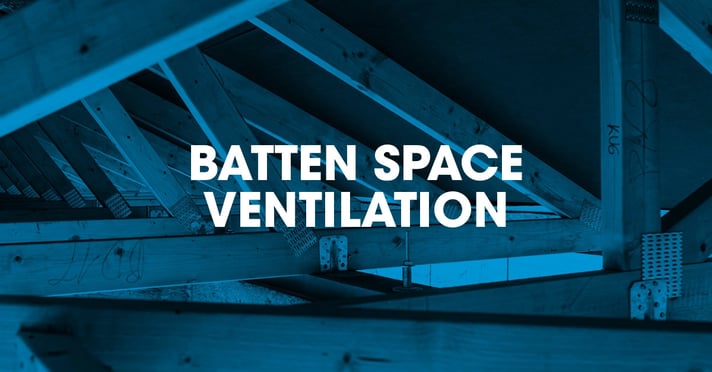What is batten space ventilation and why is it required?
Batten spaces often need to be ventilated where there is a potential risk of water vapour passing into the space between the outer roof covering and the breathable membrane and being unable to naturally dissipate due to the type of roof covering or construction type used, which allows the water vapour to condensate and accumulate in the batten space.
Batten space ventilation to cold pitched roofs with LR underlay
Where air impermeable roof coverings are used with an LR (Low-resistance) underlay to a cold pitched roof proposal, there is a risk of moisture accumulation on the underside of the outer weatherproof covering (within the batten space under the tiles). To reduce the risk of potentially damaging condensation, the batten space should be ventilated (see Figure 1). This should be achieved by means of counter battens and vents at both low and high level:
- Low-level vents should be equivalent in free area to a slot 25 mm deep running the whole length of the eaves. Over-fascia vents should provide ventilation into the batten space.
- High-level vents should be equivalent in area to a slot 5 mm deep running the whole length of the ridge in accordance with BS5250.
- Eaves vent should also provide ventilation to the cold roof void as per BS5250.
Note: Alternative methods of ventilating the batten void should provide an equivalent level of ventilation.

If the batten space is not ventilated, there needs to be an increased level of ventilation to the roof space and that should be in accordance with BS5250. The underlay manufacturer’s 3rd party accreditation also needs to be followed. It is very difficult to determine a HR or LR underlay by sight alone and the manufacturer’s third party accreditation should be referred too.
Batten space ventilation to warm pitched roofs with LR underlay
Warm pitched roofs with LR underlay, an AVCL (Air & vapour control layer) should be provided at ceiling line. Where an external covering (such as fibre cement slates) is air impermeable there is also a risk of interstitial condensation forming on the underside of the underlay and the external covering, to avoid that risk the batten space should be ventilated as described above.

Batten space ventilation to cold pitched roofs with HR underlay
A HR (High Resistance) underlay provides high vapour resistance on the cold side of the roof void, preventing the diffusion of water vapour from the loft in to the batten space; it is therefore essential that the loft space be ventilated in accordance with BS5250 and the Roofs section of our Technical manual.
Batten space ventilation to warm pitched roofs (insulation along the rafter pitch) with HR underlay
In warm roofs (with insulation along the rafter pitch) with an HR underlay, whatever form of external covering or ceiling is provided, there is a risk of interstitial condensation forming on the underside of the HR underlay; to avoid that risk, an AVCL should be provided on the warm side of the insulation, and ventilated voids should be formed between the underside of the underlay and the insulation.
Other considerations
Determining if the underlay is HR or LR
It is very difficult to determine a HR or LR underlay by sight alone and the manufacturer’s third party accreditation should be referred too.
Determining if the roof covering is air impermeable
As can be seen throughout this article, an important factor when determining if the batten space needs ventilation is if the roof covering you’ve chosen is air impermeable.
For discontinuous roof coverings (tiles, slates etc.) written confirmation and evidence must be sought from the roof cladding manufacturer confirming whether the tiles/slates are considered air permeable or air impermeable as stipulated in BS 5250:
‘The air permeability of an outer weatherproof covering comprising discontinuous units may be determined by testing in accordance with BS 5534:2014+A2:2018, Annex L, using equipment capable of measuring pressure differences of 10 Pa.’
Some tile manufacturers will not have this test information, in such cases we would assume worst case (that the tiles are air impermeable).
What are the Warranty providers concerns?
The risk of both water vapour and any water being unable to escape the batten space leads to an increased risk of materials suffering from premature degradation. This then creates a risk that affected materials may fall below the expected service life. This can ultimately lead to the failure of the roof in its primary function.
Warranty stance
Our stance is batten spaces should be ventilated for warm or cold pitched roofs where an LR (low resistance) underlay is used in combination with an impermeable roof covering.
Failure to provide the correct ventilation is considered to compromise the ability of the pitched roof construction and associated materials in meeting with the Functional Requirements and Performance Standards stipulated by the Technical Manual, notably those relating to durability and protection of materials, and those relating to achieving the required levels of ventilation provided to a pitched roof to adequately control the risk of moisture and condensation.
What Developers should action after reading this document
Developers are asked to adopt site specific practices in determining appropriate ventilation strategies for their pitched roofs based upon the factors highlighted within this document and the extensive guidance that can be found within the ‘Roofs’ section of the Technical Manual.
The determining factors for batten space ventilation is if an LR underlay is chosen in combination with an impermeable roof covering. In these situations, batten space ventilation as per the guidance above should be provided.
For Warranty purposes we require the following to be provided within design submissions:
- Design details showing the ventilation strategy for the pitched roof to be in accordance with our Technical Manual and BS5250, and;
- Third party product conformity certificate for any LR underlays used, and;
- Written confirmation and evidence must be sought from the manufacturer confirming the tiles/slates are considered air permeable or air impermeable as stipulated in BS 5250.
Any deviation from the above should be in line with BS5250 and prior agreement must be sought from your Warranty surveyor.

